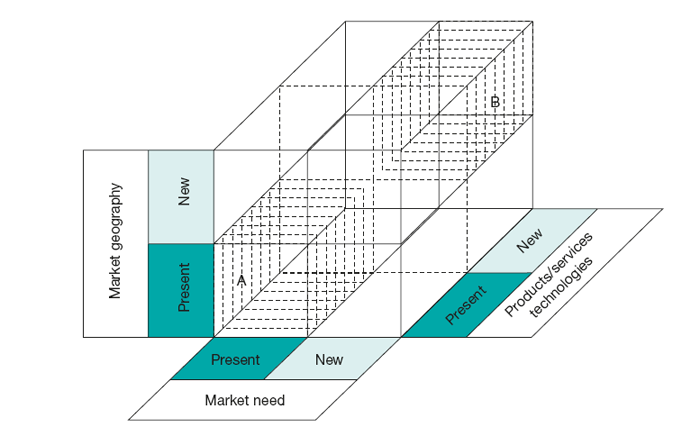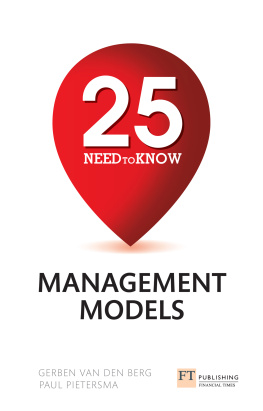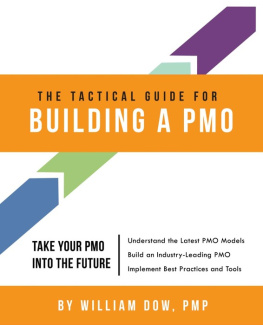Berg - Key management models: the 75+ models every manager needs to know
Here you can read online Berg - Key management models: the 75+ models every manager needs to know full text of the book (entire story) in english for free. Download pdf and epub, get meaning, cover and reviews about this ebook. year: 2015;2014, publisher: Pearson Education Limited, genre: Business. Description of the work, (preface) as well as reviews are available. Best literature library LitArk.com created for fans of good reading and offers a wide selection of genres:
Romance novel
Science fiction
Adventure
Detective
Science
History
Home and family
Prose
Art
Politics
Computer
Non-fiction
Religion
Business
Children
Humor
Choose a favorite category and find really read worthwhile books. Enjoy immersion in the world of imagination, feel the emotions of the characters or learn something new for yourself, make an fascinating discovery.

- Book:Key management models: the 75+ models every manager needs to know
- Author:
- Publisher:Pearson Education Limited
- Genre:
- Year:2015;2014
- Rating:5 / 5
- Favourites:Add to favourites
- Your mark:
- 100
- 1
- 2
- 3
- 4
- 5
Key management models: the 75+ models every manager needs to know: summary, description and annotation
We offer to read an annotation, description, summary or preface (depends on what the author of the book "Key management models: the 75+ models every manager needs to know" wrote himself). If you haven't found the necessary information about the book — write in the comments, we will try to find it.
Berg: author's other books
Who wrote Key management models: the 75+ models every manager needs to know? Find out the surname, the name of the author of the book and a list of all author's works by series.
Key management models: the 75+ models every manager needs to know — read online for free the complete book (whole text) full work
Below is the text of the book, divided by pages. System saving the place of the last page read, allows you to conveniently read the book "Key management models: the 75+ models every manager needs to know" online for free, without having to search again every time where you left off. Put a bookmark, and you can go to the page where you finished reading at any time.
Font size:
Interval:
Bookmark:

G.J.J.B. (Gerben) van den Berg (MSc) is a senior strategy consultant at Berenschot in the Netherlands. He has advised clients in a range of industries and across Europe. In his consulting practice, his core area of work is in strategy development, competitive positioning, corporate governance and (complex) organisational transformation. Gerben has a special interest in professional service firms. He is author of numerous books and articles on strategy and management, that have been translated into more than ten languages.
Paul Pietersma (MScBA MMC) is a strategy consultant and managing director of Strategy, Funding and Innovation at Berenschot in the Netherlands. He has over 15 years experience in the consulting business in which he has advised many CEOs and boards of directors in a wide range of industries in the Netherlands, Belgium, Africa and the Caribbean. He has won the Dutch Professionals Award for Management Consultancy. He is the author of numerous books and articles on strategy and management, including the best-selling previous edition of Key Management Models (2nd edition), the internationally well received The 8 Steps to Strategic Success and several leading titles in Dutch.
These models help to analyse and plan a companys strategic position and provide answers to strategic questions.


The Ansoff product/market grid offers a logical way of determining the scope and direction of a firms strategic development in the marketplace. The firms strategic development consists of two related types of strategy: portfolio strategy and competitive strategy.
The portfolio strategy specifies the objectives for each of the firms product/market combinations. It points to the dots on the horizon. The competitive strategy specifies the route to take to reach those objectives.
In the Ansoff product/market grid setting, the objectives (portfolio strategy) were introduced as choosing a growth vector, specifying the ultimate future scope of business. The growth vector is expressed in two dimensions: products and markets ().
Later, Ansoff introduced the geographical growth vector, replacing the growth vector from his product/market grid (). The geographical growth vector has three dimensions, which the firm can use to define its desired future business scope:
- the market need (e.g. need for personal transportation or need for amplification of electric signals);
- the product/service technology (e.g. integrated circuit technology);
- the market geography (e.g. regions or nation states).

Figure 1.1 Ansoffs growth vector components: products and markets
Source : after Ansoff (1987)

Figure 1.2 Ansoffs dimensions of the geographic growth vector: market need; products/services and technologies; and market geography
Source : after Ansoff (1987)
These three dimensions together form a cube. They offer a variety of combinations and strategic directions for a firm. Extreme choices are on the one hand to continue serving current regions with existing technologies to fulfil traditional needs or on the other hand to enter new regions with new technologies to fulfil new needs.
Deciding a direction and a strategy for corporate growth depends upon a number of factors, including: the level of risk involved; the current set of products and markets; and whether the organisation wants to develop new or existing products or markets. In order to plan for the future in a systematic way, it is vital that managers understand the gap between the firms current and desired positions. The Ansoff product/market grid and the Ansoff cube can be used as a framework to identify the direction of and opportunities for corporate growth.
Ansoff introduced four components that cover the portfolio strategy and help specify the desired future business scope:
- Geographical growth vector
- Competitive advantage
- Synergies
- Strategic flexibility.
The geographical growth vector can be determined with Ansoffs cube, by connecting the current scope of business with the desired future business scope.
A competitive advantage is needed both to enable the chosen scope and to be able to sustain a route towards it. The competitive advantage can be anything from a core competence or a patented technology to offering better after-sales service to clients than your competitors.
As a third strategy component, Ansoff suggests taking account of the synergy between the firms competencies. This not only enables economies of scale but can also strengthen the firms competitive position.
The fourth, and final, strategic component is the strategic flexibility. It is aimed at minimising the impact of unforeseen events and seeks to discard all unnecessary ballast.
The four components are interlinked. Optimising one of the components is likely to depress the firms performance in the others. In particular, maximising synergies is very likely to reduce flexibility. The process of selecting and balancing the strategic objectives is a complex matter.
To use the product/market grid in practice, an organisation must first assess its existing productmarket combinations and corresponding levels of competitive advantage. Then, its desired future business scope must be chosen as the geographical growth vector within the Ansoff cube.
Next, the feasibility of the chosen scope and direction should be assessed, with an analysis of the combination of the intended direction and extent of corporate growth and the firms distinctive competitive advantages (core competencies). Not only should there be the means that enable the chosen scope, those means should also provide the firm with a sustainable competitive advantage.
Then, synergies have to be found and/or created either by making use of an existing outstanding competence (aggressive synergy strategy) or by developing or acquiring the necessary competence (defensive synergy strategy).
Finally, strategic flexibility has to be attained. This can be done externally to the firm through diversification of the firms geographic scope, needs served and technologies so that a surprising change in any one of the strategic business areas does not produce a seriously damaging impact on the firms performance. Alternatively, it can be attained by basing the firms activities on resources and capabilities that are easily transferable.
A shortcut in determining the strategic objectives is to derive them from the strategic requirements of three archetype firms:
- An operating company will focus on synergies and a relatively narrowly focused geographical growth vector. Its investments are often irreversible, have long lead times and will often be in research and development (R&D) or physical assets. It must be able to anticipate change and minimise the changes of making bad decisions. Synergies will often be created around core competencies.
Font size:
Interval:
Bookmark:
Similar books «Key management models: the 75+ models every manager needs to know»
Look at similar books to Key management models: the 75+ models every manager needs to know. We have selected literature similar in name and meaning in the hope of providing readers with more options to find new, interesting, not yet read works.
Discussion, reviews of the book Key management models: the 75+ models every manager needs to know and just readers' own opinions. Leave your comments, write what you think about the work, its meaning or the main characters. Specify what exactly you liked and what you didn't like, and why you think so.














